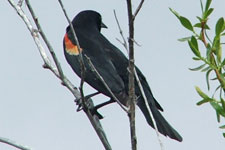Wildlife

Red-winged Blackbird
Scientific Name: Agelaius phoeniceus
Audio: Listen Now
Primary Source: Anthony Rosenthal
Photo Source: Marc Thornsbury
Audio Source: Cornell Lab of Ornithology
Addt'l Info: USDA Forest Service
Notable for the male's glossy black feathers and red and yellow epaulets at the shoulder, the red-winged blackbird is a popular, prevalent, and easily recognized bird. In the spring, it makes its presence known by singing out its familiar call, "oak-a-lee" or "konkeree".
Red-winged blackbirds roost and breed in a variety of habitats including open fields and lightly wooded forests, but prefer wetlands. Roosting is often communal resulting in large, centralized populations most often in wetlands or agricultural areas. These birds are most active during the morning and evening hours. At these times, you can often find them in the reeds, shrubs, and cattails that grow around Bingen Lake.
Where food is concerned, the red-winged blackbird is not particular. An omnivore, it eats roots, wood, bark, stems, seeds, grains, and nuts (primarily during the non-breeding season) and snails, frogs, fledgling birds, eggs, carrion, worms, insects, etc. (primarily during the breeding season). These birds maneuver easily and can catch an insect in flight.
Breeding occurs from early spring to mid-summer with one to three broods raised in a single season. Nest building begins between March and May. Where possible, nests are located in reeds, cattails, and other similar plants in or over water. Plant materials, such as cattail stalks, are woven together to form a basket above water level, and soft materials are used to line the nest. Clutch size ranges from three to five eggs and young are independent two to three weeks after birth. The average lifespan of an adult is just over two years.

